Recorded crime and police activity statistics consultation: summary of responses
Summarises the responses to the consultation on the future of recorded crime and police activity statistics. It also outlines a package of changes to the production of Scotland’s recorded crime statistics.
Outcome and next steps
Overview
We would like to once again extend our thanks to all who participated in the consultation process. All suggestions, even those not explicitly stated within this document, have been considered by the Scottish Crime Recording Board. Responses to the consultation have been published (where permission was granted) and are available to view on the consultation webpage.
The Scottish Crime Recording Board has considered the responses to this consultation, along with other feedback received from the associated events run during the consultation period and feedback from the previous consultation. Taking all this into account, the Scottish Crime Recording Board have approved a number of changes to the recorded crime statistics. These include that:
- the current set of crime and offence groups will be replaced with a new set based on Option A (as described in the consultation). The 2021/22 annual Recorded Crime in Scotland National Statistics will be the first to reflect this change.
- common assault will be reclassified as a crime rather than an offence
- stalking will be reclassified as a crime rather than an offence
- common assault will be split into common assault with injury and common assault without injury, with the timing to be confirmed for the introduction of this change
- the annual Recorded Crime in Scotland National Statistics bulletin will be published in June, brought forward from September
- the annual Recorded Crime in Scotland National Statistics bulletin will be redesigned to ensure it meets accessibility requirements and statistical best practice
- the Recorded Crime Monthly Official Statistics will be discontinued following publication of the March 2022 bulletin in April 2022
- the Monthly Official Statistics will then be replaced with a quarterly release of National Statistics, which will present the latest rolling 12-month period.
As discussed in Part Two and Part Three, the 2021 consultation also asked for feedback on potential future developments for statistics on recorded crime and police activity. This evidence will be used to inform longer term planning of these statistics, and we will keep users informed of any developments via ScotStat.
Crime Grouping Structure
The Scottish Crime Recording Board have decided that the current set of crime and offence groups will be replaced with a new set based on Option A. This will retain a similar number of groups to the current structure, but will provide more detail at the second level of disaggregation, with a 'top-50' sub-category structure.
We will continue to include additional tables within the statistics which will break down categories further for particular types of crimes where there is a known user interest. The new grouping structure is presented below for information.
Table 2: New Grouping Structure compared to the Current Grouping Structure
Current Crime Groups: Non-sexual crimes of violence
- Homicide etc. (incl. causing death by driving)
- Attempted murder & serious assault
- Robbery
- Domestic Abuse (Scotland) Act 2018
- Other violence
New Crime Groups: Non-sexual crimes of violence
- Murder and culpable homicide
- Death by dangerous driving
- Serious assault and attempted murder
- Common assault
- Robbery
- Domestic Abuse (Scotland) Act 2018
- Other non-sexual violence
Current Crime Groups: Sexual crimes
- Rape & attempted rape
- Sexual assault
- Crimes associated with prostitution
- Other sexual crimes
New Crime Groups: Sexual crimes
- Rape & attempted rape
- Sexual assault
- Causing to view sexual activity or images
- Communicating indecently
- Threatening to or disclosing intimate images
- Indecent photos of children
- Crimes associated with prostitution
- Other sexual crimes
Current Crime Groups: Crimes of dishonesty
- Housebreaking
- Theft by opening a lockfast place (OLP)
- Theft from a motor vehicle by OLP
- Theft of a motor vehicle
- Shoplifting
- Other theft
- Fraud
- Other dishonesty
New Crime Groups: Crimes of dishonesty
- Housebreaking
- Theft by opening lockfast places
- Theft from a Motor Vehicle
- Theft of motor vehicle
- Shoplifting
- Other theft
- Fraud
- Other dishonesty
Current Crime Groups: Fire-raising, vandalism etc.
- Fire-raising
- Vandalism etc.
New Crime Groups: Damage and reckless behaviour
- Vandalism
- Reckless conduct
- Fire-raising
Current Crime Groups: Other crimes
- Crimes against public justice
- Handling offensive weapons
- Not used in other criminal activity
- Used in other criminal activity
- Drugs
- Other
New Crime Groups: Crimes against society
- Crimes against public justice
- Weapons possession (not used)
- Weapons possession (used)
- Drugs – Supply
- Drugs – Possession
- Other crimes against society
Current Crime Groups: Coronavirus restrictions
New Crime Groups: Coronavirus restrictions
Current Offence Groups: Miscellaneous offences
- Common assault
- Breach of the peace etc.
- Drunkenness and other disorderly conduct
- Urinating etc.
- Other
New Offence Groups: Antisocial offences
- Threatening and abusive behaviour
- Racially aggravated conduct
- Drunkenness & other disorderly conduct
- Urinating etc.
Miscellaneous offences
- Community and public order offences
- Environmental offences
- Licensing offences
- Wildlife offences
- Other misc. offences
Current Offence Groups: Motor vehicle offences
- Dangerous and careless driving
- Driving under the influence
- Speeding
- Unlawful use of vehicle
- Vehicle defect offences
- Seat belt offences
- Mobile phone offences
- Other
New Offence Groups: Road traffic offences
- Dangerous & careless driving
- Driving under the influence
- Speeding
- Unlawful use of motor vehicle
- Vehicle defect offences
- Seat belt offences
- Mobile phone offences
- Other road traffic offences
Annex B provides a breakdown of all crime codes for the new crime grouping structure.
Overview of Grouping changes
The changes which are going to be made are highlighted below.
Non-sexual crimes of violence
- Split Homicide etc. into two categories: Murder and culpable homicide, and Death by dangerous driving
- Reclassify Common assault as a crime, sitting as its own category within the Non-sexual crimes of violence group (in 2020-21 there were just over 52,000 common assaults)
- Reclassify Stalking as a crime, sitting within the Other non-sexual violence category of the Non-sexual crimes of violence group (in 2020-21 there were around 900 offences of stalking)
- Move Female genital mutilation from Non-sexual crimes of violence – Other non-sexual violence to Non-sexual crimes of violence – Serious assault and attempted murder
Sexual crimes
- Split Other sexual crimes into five categories:
- Causing to view sexual activity or images
- Communicating indecently
- Threatening to or disclosing intimate images
- Indecent photos of children
- Other sexual crimes
Crimes of dishonesty
- No changes
Damage and reckless behaviour
- Change the name from Fire-raising, vandalism etc. to Damage and reckless behaviour
- Split Vandalism etc. into two categories: Vandalism and Reckless conduct
Crimes against society
- Change name from Other crimes to Crimes against society
- Split Drug crimes into two categories: Drugs – possession and Drugs – supply
Coronavirus Restrictions
- No changes
Offences
- Split the Miscellaneous offences group into two groups: Antisocial offences and Miscellaneous offences (multiple new categories)
- Remove Common assault and Stalking (reclassifying as Non-sexual crimes of violence)
- Change name from Motor vehicle offences to Road traffic offences
- Crime codes relating to the (mis)use of bikes moved from Miscellaneous offences to Road traffic offences
As noted above, these changes will collectively result in a 'Top 50' sub-category structure, compared to the current 'Top 35'.
Implementing the new groups
The new crime groups will be first used within the Recorded Crime annual National Statistics for 2021/22, due for publication in June 2022.
As highlighted in the consultation, it should be noted that the grouping of criminal acts is a purely statistical exercise that has no impact on how a case will be investigated or prosecuted. The new groups will be backdated within the statistics so that there is no discontinuity to the time series, and for the year of 2021/22 only, we will also publish tables using the old groups within an Annex.
Several other statistical publications make use of the crime groups, including for example criminal proceedings and domestic abuse incidents. Plans are currently being developed to ensure that these products also make a smooth transition to the new groups, protecting time series analysis and keeping users informed. More information will be provided to users of these statistics via ScotStat.
Common assault
The move to the new grouping structure includes reclassifying common assault as a crime, rather than an offence. The Scottish Crime Recording Board also agreed that common assault should be split into with and without injury and that new crime codes would be introduced to help identify police officer/staff victims of all types of assault.
In splitting common assault into common assault with injury and common assault without injury, we will be asking Police Scotland to record these crimes differently, and as such this will involve introducing new crime codes. Police Scotland are currently moving to a new national crime management system, which is being rolled out on a division by division basis.
To ensure that the new information on common assault is recorded consistently and to prevent duplication of work, the Scottish Crime Recording Board have agreed to wait until Police Scotland's new crime management system has been rolled out to all divisions before implementing this change.
The addition of the new crime codes to identify common assault and serious assault of police officer/staff will also be implemented once the new system has been fully rolled out.
Technical Report on statistical impact of changing to new groups
To ensure no break or discontinuity to time series analysis, all tables within the 2021-22 statistics will be back revised.
Those users who are familiar with the existing time series data for police recorded crime (based on the current groups) may nonetheless notice some change as we switch to the new groups. The numbers of crimes and offences in certain groups will change and in some instances, the trend over time may also change.
This is due to the fact that common assault and stalking are being reclassified as crimes, rather than offences. This means that these cases will be removed from the miscellaneous offences group and added to the non-sexual crimes of violence group. This in turn will add common assault and stalking to Scotland's recorded crime total (and remove them from the offences total).
The below analysis outlines the impact of all grouping changes on (i) the total number of crimes and offences, (ii) the non-sexual crimes of violence group and (iii) the calculation of crime clear up rates. It also presents how the 10 year and 1 year trends will be impacted by the grouping change (using 2011-12 to 2020-21 data, which is the latest published for the recorded crime National Statistics).
Impact on Recorded Crime totals
The recorded crime totals will be higher under the new grouping structure due to the reclassification of common assault and stalking as crimes. In 2020-21 there were 52,052 common assaults and 889 cases of stalking recorded. By reclassifying these as crimes, this will increase the recorded crime total by just over a fifth.
Chart 1 below shows the crime totals for the current and new groupings, highlighting the impact of the changes.
Numbers indicate 10-year trend and one-year change
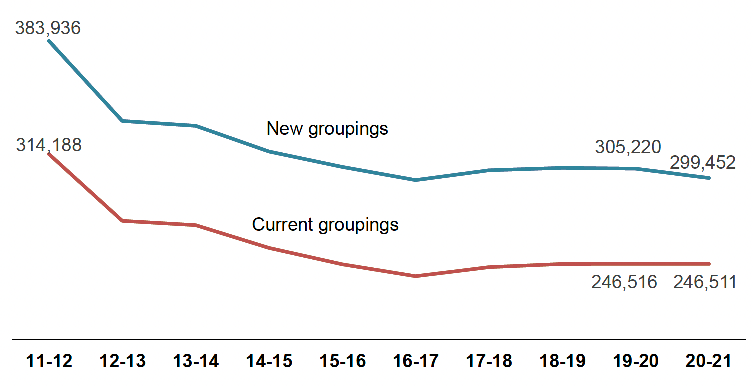
When looking at the most recent annual change, there is a small difference between the current grouping structure and the new grouping structure. The current groups show no change in the number of recorded crimes between 2019-20 and 2020-21, and the new groups show a 2% decrease over the same time period.
When looking at the longer term time series, there is a negligible impact between the current grouping structure and the new grouping structure. Both show a 22% decrease in recorded crime between 2011-12 and 2020-21.
Impact on Non-sexual crimes of violence
The non-sexual crimes of violence group will see the largest impact with the introduction of the new grouping structure. In 2020-21 there were 8,972 crimes recorded in the non-sexual crimes of violence group. This will expand to over 60,000 crimes using the new grouping structure, as common assault and stalking are moved into the group.
Whilst this is a significant change, as highlighted in Part One, feedback from users and stakeholders suggests that there is broad support for this move. By combining common assault with the existing non-sexual crimes of violence, this will present activity which is reasonably similar in scope to both the headline measure of non-sexual violence used in the Scottish Crime and Justice Survey and the equivalent recorded crime statistics for England & Wales (notwithstanding broader comparability issues in terms of how crime is counted north and south of the border). It would also be similar (though not identical) to the measure of violent crime presented in Police Scotland's quarterly performance reports.
Chart 2 below shows non-sexual crimes of violence totals for the current and new groupings, highlighting the impact of the changes.
Numbers indicate 10-year trend and one-year change
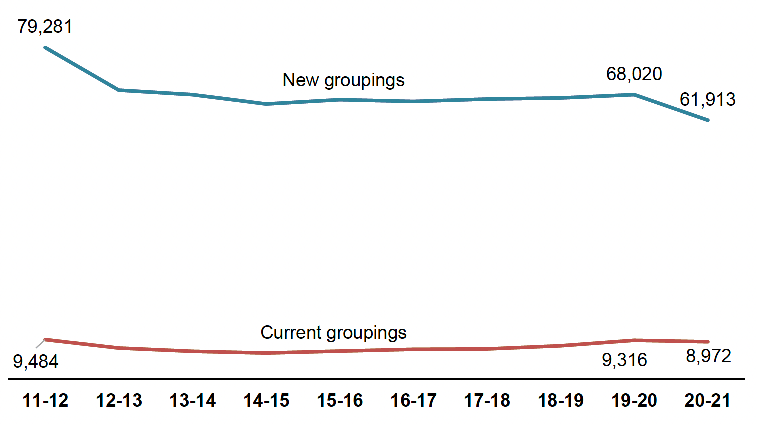
When looking at the most recent annual change, there is some difference between the current grouping structure and the new grouping structure. The current non-sexual crimes of violence group shows a 4% decrease between 2019-20 and 2020-21, and the new non-sexual crimes of violence group (expanded to include common assault and stalking) shows a 9% decrease over the same time period.
When looking at the longer term time series, there is a larger impact between the current grouping structure and the new grouping structure. The current non-sexual crimes of violence group shows a 5% decrease between 2011-12 and 2020-21, and the new non-sexual crimes of violence group shows a larger 22% decrease over the same time period.
The reason for this difference in the longer term comparison, is that the current non-sexual crimes of violence group is quite narrowly defined. This meant the inclusion of very specific types of violence, such as new crimes under the Domestic Abuse (Scotland) Act 2018 and the increase in threats/extortion (linked to the growth in cyber-crime) offset much of the long term reduction in serious assault and robbery. With the far more voluminous cases of common assault dominating the re-drawn group, a wider statistical definition of non-sexual violence will now be used.
Impact on Recorded Offence total
The offence totals will be lower under the new grouping structure, due to the reclassification of common assault and stalking as crimes. In 2020-21 there were 52,052 common assaults and 889 cases of stalking recorded, by reclassifying these as crimes, this removes just over a fifth of all offences in 2020-21. As noted above, all tables in the 2021-22 statistics will be back-revised to ensure no break to time series analysis. Such an approach finds only a small impact over the past eight years in terms of changes over time.
Chart 3 below shows the offence total for both the current and new grouping structure, highlighting the impact of the changes. The data starts at 2013-14, as previous years are not comparable.
Numbers indicate eight-year trend and one-year change
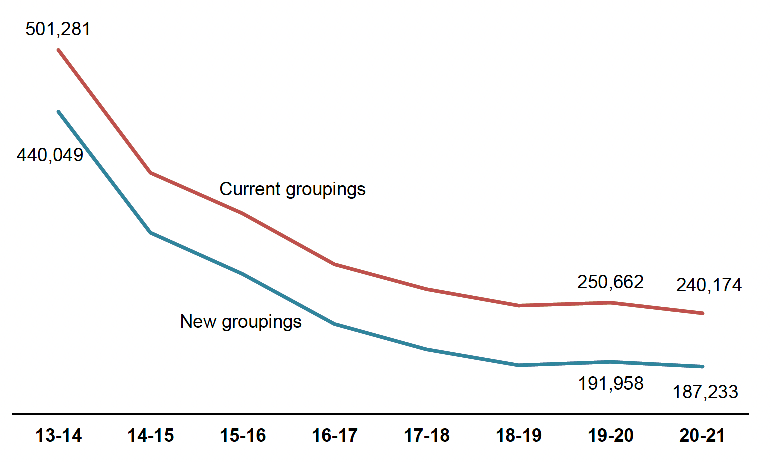
When looking at the most recent annual change, there is a small difference between the current grouping structure and the new grouping structure. The current offence groups show a 4% decrease in between 2019-20 and 2020-21, with the new offence groups showing a 2% decrease over the same time period.
When looking at the longer term time series, there is a slightly larger difference between the current grouping structure and the new grouping structure. The current offence groups show a 52% decrease between 2013-14 and 2020-21, with the new offence groups showing a 57% decrease over the same time period.
Impact on Clear up rates
Crime clear up rates (i.e. broadly the proportion of cases where police have identified a perpetrator) will also be affected by the introduction of the new grouping structure. Given common assault and stalking have higher clear up rates than recorded crime as a whole, their inclusion in Scotland's crime total leads to a higher national clear up rate (from 56.3% to 59.3% in 2020-21). There is a much more limited impact on clear up rates for the non-sexual crimes of violence group, as these are very similar to common assault. As with all of the analysis, we will back revise this change in the statistics so that there is no discontinuity to the time series.
Chart 4 below shows total crime clear up rates for the current and new groupings, highlighting the impact of the changes.
Numbers indicate 10-year trend and one-year change
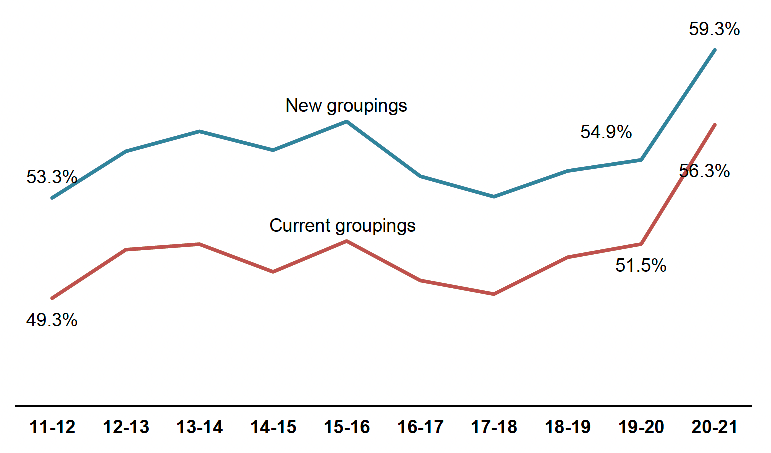
Moving to the new grouping structure leads to a higher clear up rate for recorded crime. In 2020-21, the recorded crime clear up rate using the new grouping structure is 3.0 percentage points higher than when using the current grouping structure. This is reasonably similar to the change in 2011-12, where the clear up rate for recorded crime using the new grouping structure was 4.0 percentage points higher.
Chart 5 below shows non-sexual crimes of violence clear up rates for both the current and new groupings, highlighting the impact of the changes.
Numbers indicate 10-year trend and one-year change
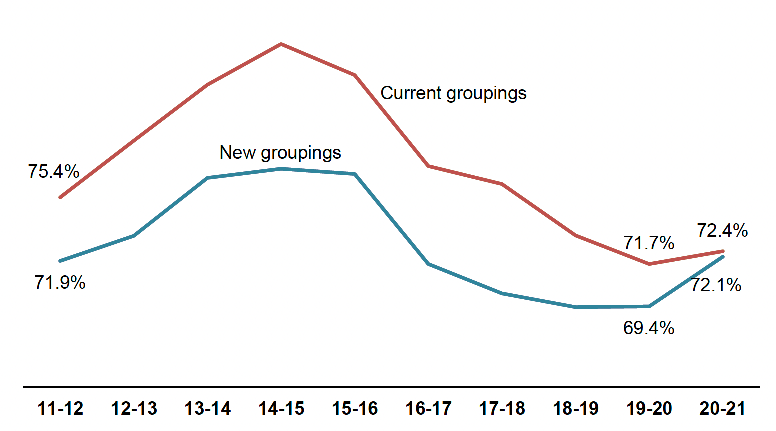
Based on the latest year, the clear up rate for non-sexual crimes of violence remains broadly unaffected by the introduction of the new grouping structure. In 2020-21 the clear up rate using the new grouping structure was 0.3 percentage points lower than when using the current grouping structure.
Dissemination of Recorded Crime Statistics
Frequency of publications
As presented in Part Two, where a preference was expressed, respondents to the consultation were generally in favour of reducing the frequency of the Monthly Recorded Crime Official Statistics publications, suggesting quarterly releases would best suit their needs.
The Scottish Crime Recording Board have therefore decided to discontinue the Monthly Official Statistics, with the final publication being for March 2022 (released in April 2022).
The Monthly Official Statistics will then be replaced with a quarterly release of National Statistics, which will present the latest rolling 12-month period. Our intention is that the first three quarterly products released each year (those covering the latest year ending June, September and December) would be;
- Similar in length to the current monthly publications,
- Will report data for a rolling year, ending with the most recent quarter, and
- Will also include a 5-year rolling time series.
Each year, the quarterly release that corresponds with a full financial year (covering year ending March or Q4) will in effect become the new annual statistics, with longer time series analysis and additional commentary. This approach brings Scotland broadly into line with England & Wales, and their quarterly releases of recorded crime statistics by the Office for National Statistics (ONS).
As part of the transition to a quarterly release schedule, and to ensure that we are publishing data in as timely a manner as possible - we will bring forward the Annual National Statistics publication to June, rather than September. As such the 2021-22 Annual National Statistics will be published on the 28 June 2022.
The planned publication timetable for the new quarterly releases of National Statistics is shown below.
| Year ending | Publication Month |
|---|---|
| 30 June (Q1) | August |
| 30 September (Q2) | November |
| 31 December (Q3) | February |
| 31 March (Q4) (Annual bulletin) | June |
Future Developments
The Scottish Crime Recording Board and Justice Analytical Services will consider the feedback from the Future developments section of the consultation in due course, and will use this feedback to inform longer term plans for the production and dissemination of Recorded Crime Statistics.
The majority of the potential future developments discussed in the consultation are linked to the implementation of Police Scotland's new crime management system. The Scottish Government will work with Police Scotland to consider any potential improvements to recorded crime data and will keep users informed of any developments via ScotStat.
Police Activity Statistics
As presented in Part Three, feedback from the consultation shows most responses are favourable to some data on non-criminal incidents being produced. Justice Analytical Services have been working with Police Scotland to get a better understanding of the data available, how this is collected and any associated limitations.
Over the coming months Justice Analytical Services will review the data further and prepare an overview paper discussing what information is available, the completeness of variables of interest, the dataset's limitations and any additional information we received from the consultation around users' needs and their requirements.
Once this paper is complete, Justice Analytical Services will consider next steps. It is likely that any resultant publications will first be produced as experimental statistics. This would allow users to feedback whether the metrics we formulate meet their needs.
Contact
Email: justice_analysts@gov.scot
There is a problem
Thanks for your feedback